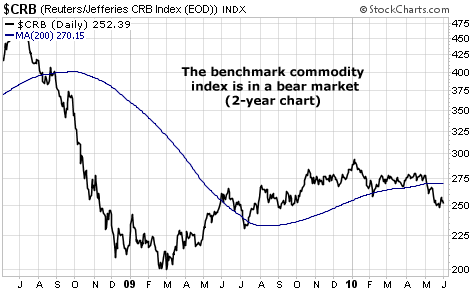| Home | About Us | Resources | Archive | Free Reports | Market Window |
Why Gold Is a Better Bet Than Oil Right NowBy
Thursday, June 3, 2010
Last month, ExxonMobil saw $38 billion erased from its market cap in just two weeks... more value than the entire market cap of most oil companies. More value than Nike's market cap.
As many DailyWealth readers know, ExxonMobil is one of the best-managed companies in the world... and one of the safest oil investments ever. The only time you'll ever see such a big chunk of hide torn from ExxonMobil is when you have a three-day period like May 4 through May 6, 2010.
During those days, NYMEX crude oil futures fell $9.08 per barrel... 10.5%. It was the largest three-day percentage decline in crude oil since June 1998. It also highlights the central problem commodity investors face right now...
Commodities have entered a bear market.
Commodities are "cyclical assets," meaning they tend to go through huge booms and busts. When folks see the price of a commodity shooting higher, they're quick to produce more and more of that commodity, which eventually brings on so much new supply it causes prices to crash.
The mirror image of this action is when the price of a commodity sinks to new lows. This is when folks shut down production in order to stop bleeding money on a mine or oil well. Supply gets pinched, and prices skyrocket.
Now I'm no hardcore devotee of technical analysis (also known as chart reading), but I do know it's suicide to buy into a commodity downtrend. No matter how great an oil company is, if the price of oil is sinking, its shares are going lower. To size up commodity trends, I use what's called a "200-day moving average" (200-DMA).
A moving average simply takes the closing prices over a given time period – in this case the last 200 days – and averages them together. The 200-DMA smoothes out day-to-day volatility to give us a view of the trend.
Bull markets never go straight up. But when a market is trading above its 200-DMA, you can figure it's in a bull trend. When a market is trading below its 200-DMA, you can consider it to be in a bear trend. The chart below is the benchmark commodity index plotted with its 200-DMA. You can see it is now officially in a bear market... and caution should be our main strategy here.
 What does this cautious stance actually mean for investors?
It means being extra mindful of your protective stop losses... and avoiding big position sizes.
Two particularly risky areas are oil stocks and base metal stocks. Oil and copper are highly dependent on the global economy. Any slowdown in Europe or China and they'll suffer. I think the recent downturn will eventually produce some spectacular bargains (especially in oil services), but I'd rather see folks focus on gold stocks and natural gas stocks right now.
You see, while oil companies like ExxonMobil were selling off last month, gold stocks and natural gas stocks held steady. I've profiled why you should be long natural gas here and here. It was too beaten down to sink any lower during the May selloff. And gold?
Last month, I told you gold is being increasingly viewed as a safe-haven currency by big money investors. It's not behaving like a typical commodity. Gold demonstrated this "not a commodity" attribute by holding steady during the May selloff. Gold stocks like Newmont Mining and Barrick Gold held steady in turn.
Keep in mind... oil and copper prices in particular are dependent on the global economic situation. Ask 10 analysts their take on the situation, and you'll get 10 different answers. But you can be sure natural gas and gold stocks are holding up extremely well while much of the commodity complex is weak. This leads me to recommend them as the best places for commodity investors right now.
Good investing,
Further Reading:
For years, big gold miners have been hampered by the soaring cost of fuel and infrastructure. But as Matt recently told Growth Stock Wire readers, that's finally turning around. "If they can continue to hold costs steady, the rising gold price means gold profits will explode... and share prices will follow." Find the rest of the story, and a quick list of big gold miners profiting off the trend, here: The Gold Trade of the Year Is Ready Right Now.
Market NotesTHIS STOCK WILL BE A GREAT TRADE SOMEDAY One of the best friends a trader can have is the "blood in the streets" selloff in a given asset class.
After that kind of devastation, a trader can buy low... and sell much higher during the explosive move when things finally go from "bad to less bad." It's a phenomenon that allowed us to go three-for-three in picking 100%+ winners with our December 2008 rebound-trade series (gold stocks, infrastructure, and emerging markets).
We bring up "blood in the streets" today because this is the situation in the oil drilling sector right now. A general decline in oil prices, plus the Deepwater Horizon explosion, has hammered even the bluest of blue-chip oil drillers. Most are down 30% to 40% in the past month.
One driller we'd like you to add to your watch list is Transocean (RIG). RIG is the world's largest offshore drillship operator... and the Deepwater Horizon was RIG's ship.
|
In The Daily Crux
Recent Articles
|

